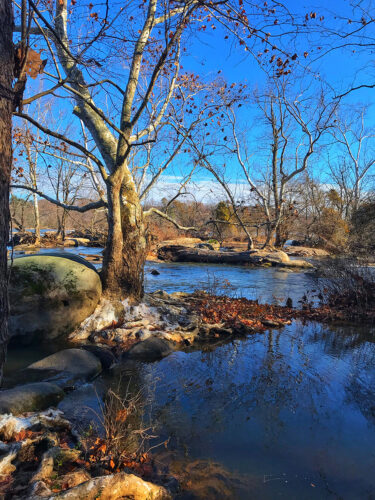
Trees and Shrubs to Protect Water Quality
Read about riparian forest buffers and how trees and shrubs protect water quality.
Forest Buffers in Urban Areas
Since early colonization in Virginia, settlement has clustered along waterfronts and many of these areas have grown into our major metropolitan centers today. Removal of streamside vegetation for changing land uses and infrastructure development has reduced the natural filtration of streams and other bodies of water. Many urban waterways have lost benefits for wildlife and passive recreation for people.
Local governments are faced with the challenge of planning riverfront re-development with residential, commercial, and industrial sites for economic growth, while also creating better river function for flood control and water supply. To achieve these goals, riparian buffers of trees, shrubs, grasses, and perennial ground covers can be restored along the rivers, streams, ponds, lakes, and other natural or man-made water features in developed areas.
To support clean water and healthy communities, VDOF provides support to establish these riparian buffers, including project coordination, technical assistance, education, professional development, academic program support, and grants for specific projects.
Benefits of Urban Riparian Forest Buffers

Urbanization has adverse effects on the landscape, but the inherent benefits of riparian buffers can offset many of the effects of development.
- Social Benefits: includes (but not limited to) shade, clean air, clean water, community revitalization, community health and well-being, business district enhancement, and general aesthetics of the corridor.
- Recreation: camping, nature study, photography, hunting, and fishing.
- Stormwater Management: attained through riparian buffer function, including nutrient processing, pollutants trapping, and sediment storage.
- Wildlife Support: support natural predators of rodents and other pests, protect fish and wildlife habitat, and provide corridors for urban wildlife breeding and travel.
- Air and Water Quality: carbon sequestration in riparian forest buffers improves air quality; nitrogen and phosphorous pollutant reduction improves water quality.
- Economic Benefits: includes flood protection, reduced soil erosion, protection of public drinking water supplies, and tourism opportunities.
Planting Urban Forest Buffers
Establishing new riparian buffers on open land where they don’t currently exist, or expanding existing buffers provide many benefits described previously. Riparian forest buffer species include trees and shrubs adapted to tolerate periodic flooding and saturated soils.
VDOF Seedling Nurseries grow riparian tree species for sale in our seedling store.
VDOF provides assistance to landowners and communities in planning how best to establish a buffer. Steps often include getting the land ready (preparation), planting trees or ensuring natural seeding of new trees, and follow-up.
Get help with planting riparian forest buffers.
Additional Resources
[posts_table columns="image,title:Title,cf:id_number:ID,content:Description,tax:Media,button" post_type="document-library" rows_per_page="5" exclude_term="Audiences:no, Media:news-releases" term="document-tags:riparian-forest-buffers" filters="tax:document-category:Select Category,tax:Media:Select Content Type" search_box="true" reset_button="true"]A variety of financial assistance programs are available through VDOF and partner agencies for forest management activities to help protect water quality.
Explore All Financial Assistance Programs
Contact Us
Your local VDOF forester can provide guidance with planting riparian forest buffers. Contact your local VDOF forester.
For more information or questions, e-mail us or use our contact form.
